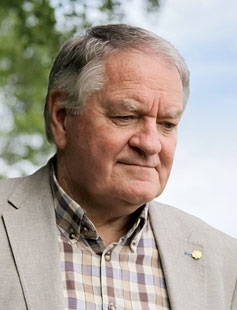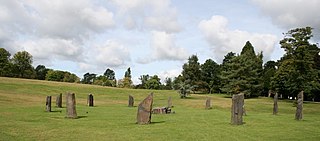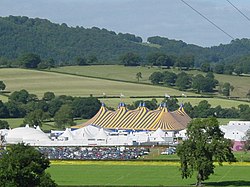
In Welsh culture, an eisteddfod is an institution and festival with several ranked competitions, including in poetry and music. The term eisteddfod, which is formed from the Welsh morphemes: eistedd, meaning 'sit', and fod, meaning 'be', means, according to Hywel Teifi Edwards, "sitting-together." Edwards further defines the earliest form of the eisteddfod as a competitive meeting between bards and minstrels, in which the winner was chosen by a noble or royal patron.

Dafydd Iwan Jones is a Welsh singer and nationalist politician who rose to fame writing and performing folk music in the Welsh language. From 2003 to 2010, Iwan was the president of Plaid Cymru, a political party which advocates for Welsh independence from the UK.

Gorsedd Stones are groups of standing stones constructed for the National Eisteddfod of Wales. They form an integral part of the druidic Gorsedd ceremonies of the Eisteddfod. The stones can be found as commemorative structures throughout Wales and are the hallmark of the National Eisteddfod having visited a community.

Reverend Rowland Williams, commonly known by his bardic name "Hwfa Môn", was a Welsh clergyman and poet, who served as Archdruid of the National Eisteddfod of Wales from 1895 to 1905.

John Owen, also known by his bardic name Owain Alaw Pencerdd, was a Welsh-language poet and also a musician.
In Wales, the office of Mayor or Lord Mayor had long been ceremonial posts, with little or no duties attached to it. Traditionally mayors have been elected by town, borough and city councils. Since 2000, councils can decide to have directly elected mayors with extensive powers if such a proposal is approved in a local referendum.
Andrew M. Green MCLIP, FLSW is a former librarian at the National Library of Wales in Aberystwyth, who held the role from 1998 to 2013. His predecessor was J. Lionel Madden. The role has been influential in Wales, since John Ballinger first took up the position in 1909.

The Urdd National Eisteddfod is an annual Welsh-language youth festival of literature, music and performing arts organised by Urdd Gobaith Cymru. It is the youth counterpart to the National Eisteddfod of Wales. Arguably Europe's largest youth festival, it is usually held during the last week of May, coinciding with schools' half term holiday. Locations alternate between north and south Wales. The Eisteddfod consists of competitive singing, recitation, art, composition, dance and instrumental events for contestants aged between 7 and 24 years. Regional qualifying heats are held in advance around Wales.

David Griffith, known by the bardic name of Clwydfardd, was a Welsh poet and Archdruid of the National Eisteddfod of Wales.
Geraint Lloyd Owen is a Welsh-language poet, also known by his bardic name Geraint Llifon. He is a retired head teacher and was the Archdruid of the Gorsedd between 2016 and 2019.
Selwyn Griffith was a Welsh language poet and the Archdruid of the National Eisteddfod of Wales, known by the bardic name Selwyn Iolen.

Robert Rees was a Welsh tenor and musician. He was a successful competitor at eisteddfodau for which he adopted the pseudonym Eos Morlais, and in 1867 he won the main prize as a vocalist at the National Eisteddfod of Wales. He was recognised as one of the leading Welsh soloists of his time.

Golf is a popular sport in Wales. Although the sport of golf in Great Britain is most associated with Scotland, where it was established and developed, Wales can record its first courses back to the 1880s, and today has over 200 clubs. The first amateur golf competition was held in 1895, and the first professional championship was in 1904. Wales has produced several players of note, including one player, Ian Woosnam, who has won one of the Men's major golf championships and Wales has twice won the men's World Cup, in 1987 and 2005, respectively. Wales also hosted the Ryder Cup, when it was held at Newport's Celtic Manor Resort in 2010.

The Gold Medal of the National Eisteddfod of Wales is awarded annually in three categories for excellence in Fine Art, Architecture, or Craft and Design.

Candelas are a Welsh rock band from Llanuwchllyn, North Wales.

The 2018 Cardiff National Eisteddfod was held in Cardiff Bay, Wales, from 3 to 11 August 2018. It was the seventh time the National Eisteddfod of Wales had been held in Cardiff. The 2018 event was billed as the Eisteddfod with "No fences" because it dispensed with the traditional enclosed 'Maes', or entrance fees to the event location. It made a £290,000 loss, but its popularity led to the suggestion of future Eisteddfods without fences.
Gwilym (transl. William) are a Welsh-language pop rock group from Anglesey and Caernarfon. The band consists of members Ifan Pritchard, Llyr Jones, Llew Glyn, Rhys Grail, and Carwyn Williams. The group was founded in 2017.
List of winners of the Welsh Learner of the Year, a competition held every year at the National Eisteddfod of Wales.



















